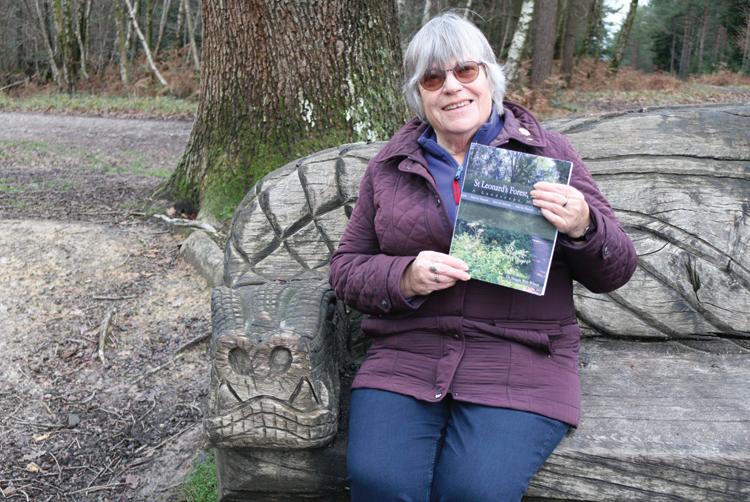
4 minute read
St Leonard’s Forest
Dr Maggie Weir-Wilson with her book.
Advertisement
Have you ever wondered about St. Leonard’s Forest as you pass it by in your car, bicycle, or in the bus; maybe you have walked its footpaths, with or without a dog? Was it a royal forest? Who owned it? And what about the dragon? Wasn’t there something about a saint and the white and pink spring flowers, lily of the valley? Wonder no more.
This is the first in depth study of St. Leonard’s Forest and it is clear from reading this thoroughly researched and engaging book that its author, Dr Maggie Weir-Wilson, has a deep interest in and love of the Sussex landscape, particularly its forests. St Leonard’s Forest, West Sussex: A Landscape History, covers the period from approximately the mid-18th century to the beginning of the 20th century. To make sense of the Forest’s development, this volume is set in its earlier historical and geographical context; Maggie researched how social and economic history effected this forest landscape. St. Leonard’s Forest, West Sussex: A Landscape History focusses on both the physical and social changes to the landscape of St. Leonard’s Forest and how these changes have impacted its population and growth. Follow the Forest’s journey from the early days of hunting, iron and charcoal production, stone quarries, rabbit warrens and poor heathland, through to the transformation to high value properties with attractive gardens and parks. Five estates in the centre of the forest are considered, and inevitably St. Leonard’s dragon has his story told, along with other forest legends and myths.
When she came to live in Horsham in the year 2000, Maggie was keen to know more about this lovely forest on her doorstep, so she began taking evening classes at the University of Sussex for a BA in Landscape Studies. When she retired from her work as a Probation Officer and Practice Teacher, she continued studying for her doctorate under the supervision of Professor Brian Short, and produced her thesis on the historic landscape changes of St. Leonard’s Forest. Maggie was awarded her doctorate in 2014 and has always been keen to make her research more widely available to West Sussex residents, historians and those who love forests, hence she wrote St Leonard’s Forest, West Sussex: A Landscape History.
During the last two years Maggie has worked extensively to write her book. Jeremy Knight, Museum and Heritage Officer with Horsham Museum, kindly read Maggie’s draft and offering detailed feedback. In addition, Maggie has had the support and blessing of Emeritus Professor Brian Short of University of Sussex who has encouraged her efforts in writing this book. Bryan's support extended from being Maggie's supervisor, guiding her towards her DPhil thesis in 2014, through to writing the foreword for this book. Maggie’s first publication was Secret Horsham (2019) published by Amberley Publications. St Leonard’s Forest is her second book, and is published by new local publishers and complete author support team, Author’s Pen.
Not keen to sit around since completing her doctorate, Maggie has focussed on writing, both fiction, non-fiction and also poetry. Maggie’s other
hobbies include: research, poetry, botanic watercolour painting, local history and gardens. St Leonard’s Forest, West Sussex: A Landscape History, has allowed Maggie to combine a number of these hobbies and really challenge them and herself. Her watercolours and poetry make a beautiful addition throughout her St Leonard’s Forest book.
Maggie hopes her book will encourage everyone who reads it to consider the value of the landscape, and particularly its forests, not purely in terms of the financial value of their land, mineral and plant content, but also in terms of their undoubted value for the mental health and wellbeing of our society. Maggie’s book touches on the fascinating subject of terrapsychology, which rejects the concept that the earth is of use only as a source of resources for humanity, but rather looks at it as a living ecosystem which impinges on the human psyche in a positive or negative way. The ways it does this can be recognised as feelings, dreams and archetypes, such as the dragon and devil that appear so frequently in the myths of St. Leonard’s Forest.
Ultimately, though there is encouragement to get to know St Leonard’s Forest by the footpaths that were so nearly closed at the beginning of the 20th century, and to give thanks to those locals who fought to keep those footpaths open and who won the day. To walk through St Leonard’s Forest and appreciate its history, its legends, and get that restorative feeling that can only come from the sight and smell of pine, beech, oak and birch.
Readers can find out more about Maggie, her book about St. Leonard’s Forest on her website: www.maggieweirwilson.uk. Copies of St Leonard’s Forest, West Sussex: A Landscape History can be ordered through high street and online retailers, the ISBN for the print book is: 9781838343606 and the e-book: 9781838343613
Helping you make the right decisions
WS32852 12.2020 Whether you’re arranging care in your own home or thinking of residential care, it can be difficult to decide on the best way to pay your care fees. Contact the Carewise care funding scheme for expert independent financial advice, based on your personal circumstances. They can also help you to organise your finances so you can provide for your family.

Book your free consultation
Visit www.carewiseadvice.com, email socialcare@westsussex.gov.uk or phone 01243 642121 and ask for a Carewise referral, quote ref: HP01/21










